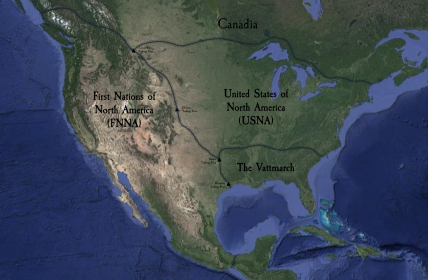North America in Parallel 34.21.12

First Nations of North America (FNNA)
The FNNA was originally a loose association of First Nations peoples across western North America. Early contact with what are today suspected to be aliens provided them the basics of technology and a massive increase in agricultural efficiency. By 550 CE various tribes in the west had joined in a confederation of peoples reaching from southern Mexico to Vancounver and from the Pacific to east of the Rockies: The First Nations of North America.
After the brief conflict with the expanding Vattmarch, FNNA determined to enforce their sovereignty and borders - they had been warned by their alien patrons to be vigilant or be wiped from existence.
The Vattmarch
In 1107 CE, King Sigurd 1 of Norway launched the Norwegian Crusade, the first time a European king personally led a crusade into the Holy Land. In response, several caliphates invaded Scandinavia, engaging in a savage genocidal rampage, a kind of counter Crusade. Over the next 20 years tens of thousands fled Sweden, Norway, and Denmark.
The Scandinavian refugees sought safety in Vinland (Newfoundland), across the Atlantic Ocean. They continued south, eventually settling in the Southeastern part of North America. They mixed with immigrants from Spain, French Canadia, Africa, and the Caribbean. The resulting Creole people are a cultural blend of pagan/Norse, Spanish, French, and African traditions and religion. Thor, Jesus, and Baron Samedi all have their parts to play. They named their new homeland "Vattmarch", or "wet land" in their blended language.
By the mid 1400s, this culture had spread from modern day South Carolina to eastern Texas, including all of the swamplands of the Gulf coast. Agriculture and population growth pushed them west, and in 1440 they came into contact with FNNA settlements. The Vattmarchers employed their typical Viking tactics of violent plunder; however, the First Nations people were unexpectedly resilient. After a few years of skirmishing, they came to a reasonable peace and trading relationship.
European colonization attempts in North America largely stayed clear of the Vattmarch, although each country clearly had designs on it. The Vattmarchers made it clear that while temporary military control of smaller regions of the Vattmarch might be possible, such things were not well tolerated by the Voodo Vikings, and they always ended in violent defeat of the invaders. Survivors told horrific stories.
United States of North America (USNA)
British colonization during the 1600s resulted in the formation of 11 colonies, from North Carolina in the south to Maine in the north. In 1775, the colonies declared their independence from Britain, and with help from the Vattmarch1 to the south and France via Canadia to the north, by 1788 the British were widely recognized to have lost. The British do not acknowledge this defeat, and continue to attack the USNA both in North America and abroad.
In the wake of their successful break with Britain, USNA expanded west as far as the Dakotas, Nebraska, Kansas, Oklahoma, and part of Texas. The FNNA had already established clear borders by this time, so the USNA had reached the conclusion of its "manifest destiny" by the time they reached Colorado.
Slavery was outlawed in the Vattmarch in 1478; the Vattmarch helped with the war against the British on the condition that the new USNA abolished slavery. The Americans couldn't win without the help, and under the new USNA slavery was abolished.
Please see the note on historical revisionism and fictionalization.
The Mythras game system, rules, etc., and all settings published by them, are copyright The Design Mechanism.
Material on this site not covered by other ownership or copyright statements is Copyright © 2023 Robert Prince.